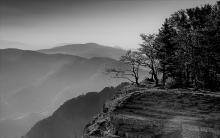11. Saṃlāpaka – A saṃlāpaka has either three or four acts and the nāyaka is a pāṣaṇḍa[1], i.e., a heretic. The play evokes all rasas except for śṛṅgāra and karuṇa. The plot consists of the story of an attack on a town, a display of pride, a suggestion of war and other manmade and natural calamities. Bhāratī-vṛtti and kaiśikī-vṛttis are absent. Example: Māyākāpālika.
Author:hari
ऐसी ही घटना को आज हम गांधी-नेहरु काल में देख रहे हैं – यदि नेहरु जैसा व्यक्ति गांधी का उत्तराधिकारी हो सकता है तो यह गांधी के सिद्धांतों की वास्तविकता को दर्शाता है। जब हम देखते हैं कि किस प्रकार सुभाषचंद्र बोस, सरदार वल्लभ भाई पटेल और राजगोपालाचारी जैसे सुयोग्य व्यक्तियों पर दबाव डाल कर उन्हे हटा दिया गया तो यह स्पष्ट हो जाता है कि गांधी किसके पक्ष का समर्थन जुटाने में संलिप्त थे। भूतपूर्व जोधपुर विश्व विद्यालय के दर्शनशास्त्र के प्राध्यापक डा.एम.एम. कोठारी ने ‘क्रिटिक ऑफ गांधी’ नामक एक मूल्यवान पुस्तक लिखी है। उसमें इस प्रकार की अनेक घटनाओं का विवरण है। डा.
Vedanta is not antithetical to Christism or Islam. Even if we say that divine principle resides outside man, Vedanta does not say that it is wrong.
antarbahiśca tatsarvaṃ vyāpya nārāyaṇaḥ sthitaḥ ।
-Mahānārayaṇopaniṣad 13.5
प्रकाराः
दत्तपदीयं द्विप्रकारा सुकरा दुष्करा चेति । एतौ प्रकारौ सुयोज्या दुर्ज्योज्या चेत्यपि शक्यौ वक्तुम् । असौ तावदत्राभिप्रायः ।
सुकरदत्तपदी - यदि दत्तानि पदानि निर्दिष्टे विषये भाषायां च सुखेन योजयितुं शक्यानि तर्हि सा सुकरदत्तपदी । यथा वर, कर, चिर, सुर चेति । एषां पदानां संस्कृतपद्ये निवेशो नितान्तं सुशकः । तदाकारकाणां शब्दानां संस्कृते सहजतया उपलभ्यत्वात् ।
Upa-rūpakas
The Sāhitya-darpaṇa defines eighteen uparūpakas namely, nāṭikā, troṭaka, goṣṭhī, saṭṭaka, nāṭya-rāsaka, prasthāna, ullāpya, kāvya, preṅkhaṇa, rāsaka, saṃlāpaka, śrīgadita, śilpaka, vilāsikā, durmallikā, prakaraṇī, hallīśa, bhāṇikā
Ḍima – A ḍima is based on prakhyāta-vastu, i.e., a popular story. It is filled with supernatural and magical elements; eclipses and wars also come as a part of this genre of play. Radura is the primary rasa. The play is completely devoid of śānta, hāsya, and śṛṅgāra rasas. A ḍima typically consists of four aṅkas; connecting segments such as the viṣkambhaka and praveśaka are absent.
अशोक की अहिंसा नीति का आकलन
इत् सिंग जैसे चीनी यात्री के अभिलेखानुसार अशोक एक सन्यासी तथा बौद्ध भिक्षु था। उनके कथनानुसार उन्होने ऐसी प्रतिमा के दर्शन भी किये हैं। बौद्ध व्यवस्था में कोई भी सन्यासी पुनः गृहस्थ जीवन में प्रवेश कर सकता है। वे किसी भी अन्य आश्रम में प्रवेश कर सकते है।
Thoughts on the Three Matas
It has become common practice among us — notably among Brahmins — and especially among those who think they have understood the essence of a mata, to argue whether it is Dvaita, Advaita or Viśiṣṭādvaita, when they are faced with the prospect of understanding philosophical texts such as the Gītā or the Upaniṣads. When I translated Vedic texts such as the Puruṣa-sūkta into Kannada, many people would ask me this same question. I would reply in one of the following two ways :
ಭಂಗೀಭಣಿತಿ
ಎಷ್ಟೋ ಬಾರಿ ಮಹಾಕವಿಗಳು ತಮ್ಮ ಕಾವ್ಯದ ನಡುವೆ ಪ್ರೌಢವೂ ಸಾಭಿಪ್ರಾಯವೂ ಆದ ಹೇಳಿಕೆಗಳನ್ನು ಮಾಡುವುದುಂಟು. ಇವುಗಳೆಲ್ಲ ಕಟ್ಟಕಡೆಗೆ ರಸಧ್ವನಿಯಲ್ಲಿ ಪರ್ಯವಸಿಸುತ್ತವೆಂಬುದು ಸತ್ಯ. ಆದರೆ ರೂಪದ ಮಟ್ಟಿಗೆ ಇವನ್ನು ನಿರ್ದಿಷ್ಟವಾದ ಒಂದು ಸ್ಫುಟಾಲಂಕಾರದಲ್ಲಿ ಅಳವಡಿಸಲಾಗುವುದಿಲ್ಲ; ಲಕ್ಷಣೆ ಮತ್ತು ವ್ಯಂಜನೆಗಳಿಗೂ ನೇರವಾಗಿ ತಳುಕು ಹಾಕಲು ಅನುಕೂಲಿಸುವುದಿಲ್ಲ. ಇಂಥವನ್ನು ಕುಂತಕನ ಮಾತಿನಂತೆ ‘ಭಂಗೀಭಣಿತಿ’ ಎನ್ನಬಹುದು. ಕನ್ನಡದಲ್ಲಿ ಡಿ.ವಿ.ಜಿ., ಕುವೆಂಪು, ಪುತಿನ ಮೊದಲಾದವರಲ್ಲಿ ಇವನ್ನು ಹೇರಳವಾಗಿ ಕಾಣಬಹುದು. ಪೈಗಳೂ ಇವರ ಸಾಲಿಗೆ ಸೇರುತ್ತಾರೆ. ಅವರ ‘ಯಾರೆಂಬರು ಮುಗಿದುವೆಂದು ಬವರಂ?’ ಎಂಬ ಕವಿತೆಯಿಂದ ಕೆಲವು ಸಾಲುಗಳನ್ನು ಉದಾಹರಿಸಬಹುದು:
Nāṭaka, prakaraṇa, bhāṇa, prahasana, ḍima, vyāyoga, samavakāra, vīthi, aṅka, and īhāmṛga – these constitute the ten rūpakas, i.e., the ten different genres of Sanskrit drama. The following are their main features as per the Nāṭyaśāstra and Sāhitya-darpaṇa.







